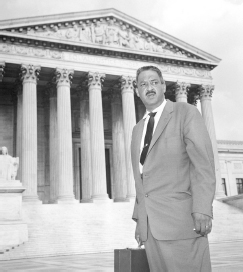Freedom Riders - American civil-rights demonstrators who engaged (1961) in nonviolent protests against segregation of public interstate buses and terminals in the South

Selma to Montgomery March - When the march began on 7 March, there followed one of the most vicious assaults in the history of the Civil Rights Movement. Troopers attacked the demonstrators with tear gas, while Clark and his men used bull whips and rubber tubing wrapped in barbed wire. All this was seen on national television.
Black Panther Party - The Black Panthers called on African Americans to arm themselves for the liberation struggle. In the late 1960s party members became involved in a series of violent confrontations with the police (resulting in deaths on both sides) and in a series of court cases, some resulting from direct shoot-outs with the police and some from independent charges.

Malcolm X - An extraordinary orator, a self-taught intellectual, and a deeply spiritual man, Malcolm X was one of the most prominent African American political and religious leaders of the civil rights era.

John Lewis - was involved in the civil rights movement and participated in sit-ins and worked with the Freedom Riders. He was arrested over forty times and was attacked and beaten by an angry mob. Lewis was associated with several social activist organizations, including the Student Nonviolent Coordinating Committee; he served as associate director of the Field Foundation, project director of the Southern Regional Council, and executive director of the Voter Education Project, Inc.

Thurgood Marshall - US jurist and civil-rights leader. As a prominent civil-rights lawyer, he frequently presided over landmark cases such as Brown v. Board of Education (1954).

Civil Rights Act of 1964 - A landmark law that outlawed discrimination in employment, public accommodations, and other areas.
Voting Rights Act of 1965 - Prohibited states from imposing discriminatory voting practices, such as literacy tests.
Civil Rights Act of 1968 - Also known as the Fair Housing Act, this act prohibited discrimination in the sale, rental, and financing of housing.
Equal Employment Opportunity Act of 1972 - Strengthened Title VII of the Civil Rights Act of 1964 by providing additional enforcement powers to the EEOC.
Civil Rights Restoration Act of 1987 - Required educational institutions receiving federal funding to comply with all federal civil rights laws.
Civil Rights Act of 1991 - Strengthened federal civil rights laws, including protections against employment discrimination.
The Supreme Court's Brown v. Board of Education of Topeka decision (347 U.S. 483 [1954]; 349 U.S. 294 [1955]) was actually four cases considered under one rubric, with a companion case, Bolling v. Sharpe (1954). The central question considered was whether legally imposed racial segregation in public primary and secondary education violated the equal protection clause of the Fourteenth Amendment, while Bolling took up the segregation issue for the District of Columbia and the due process clause of the Fifth Amendment.
Brown v. Board of Education (1954) - the Supreme Court ruled that separating children in public schools on the basis of race was unconstitutional. It signaled the end of legalized racial segregation in the schools of the United States, overruling the "separate but equal" principle set forth in the 1896 Plessy v. Ferguson case.

Little Rock Nine - the first African-American students to attend Little Rock Central High School. The group was escorted to the high school by Little Rock police but they quickly departed after an angry white mob threatened to riot.
Smithsonian National Museum of African American History and Culture - Our American Story - The Little Rock Nine
Griffin v. Prince Edward County, Virginia - Prince Edward County had been involved in one of the four original cases that were grouped together in Brown v. Board of Education of Topeka in 1954, when the Court declared racial segregation of schools unconstitutional and ordered all school boards to desegregate schools "with all deliberate speed." Prince Edward County, however, closed its public schools rather than permit racial integration, but it then used public moneys to support a group of private schools that white parents had opened for their children. - Unger, Harlow. “Griffin v. Prince Edward County, Virginia.” Encyclopedia of American Education.
Civil Rights Movement in Virginia - Virginia Museum of History and Culture
